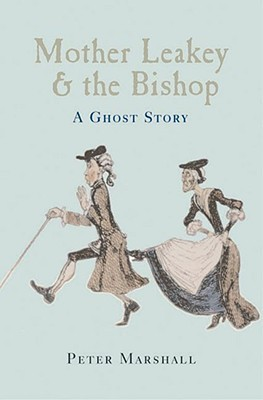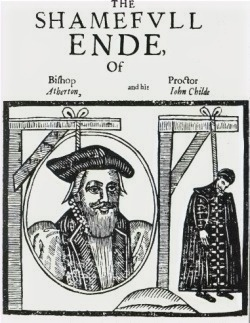
Today we’re looking at Bishop Atherton of Waterford, the only Anglican Priest to ever be put to death for the crime of ‘buggery’ – but did he do it? Or was he the victim of an invented crime by powerful people who feared his influence? His ghost certainly seems to think so…

Thomas Atherton was born in Somerset and educated in Oxford University, but travelled to Ireland to begin his career, supposedly leaving England under something of a cloud. He began as Chancellor of Christchurch Cathedral, and began to climb quickly once he gained powerful patronage. In 1636 he was made Bishop of Waterford and Lismore and his career seemed to be really taking off, but this is where the trouble began as also in 1636, Atherton received a chilling warning. His wife’s mother had passed away some years earlier, but on Halloween 1636, almost four-hundred years ago, she returned to deliver a message. Asking another daughter to warn her sister, Atherton’s wife, Old Mother Leakey (as she is known along to coast of Somerset) accused Atherton of incest, infanticide and other crimes, she warned that if he did not repent for his sins he would shortly be hanged. Whether he was guilty of these we will never know, but just four years later he would be executed for a very different reason. As for Old Mother Leakey, it is said she spent the years after whipping up storms and driving ships to wreck and ruin in the
seas around her old home, apparently for revenge on her son…
The Bishop had made some powerful enemies during his time in Ireland, as had his patron, Thomas Wentworth, 1st Earl of Strafford. Wentworth was Governor of Ireland from 1632 to his death in 1641 and proved notoriously unpopular among the landed gentry here for trying to curb their influence and increase the crown’s power and income. Wentworth’s actions led to his own execution in 1641, with the appointment of Atherton listed among his crimes.
The main source of ire was the fact that Atherton was instituted with a plan in mind: to reform the impoverished church and lessen the influence of wealthy parishioners, and wrestle church lands and goods from private hands. Obviously, this was not a very popular move among the families who made their fortunes from the lands they owned and rented, and resentment began to brew. Here in Waterford, Atherton was part of the group who reclaimed all of our medieval church silver, only to have it melted down and converted to cash in the late 1630s.
It is unclear what the last straw was, but in 1640, Atherton was accused of the crime of ‘buggery’ (homosexuality). He staunchly denied this, but eventually admitted to crimes not befitting of his role in the church, such as adultery and the reading of ‘naughty books’. However this all fell apart when a witness and ‘partner in crime’ came forward – John Childe.n

Despite the lack of any real evidence other than the spurious testimony of his own steward and tithe proctor – John Childe – Atherton was put on trial and found guilty of the crime of buggery. He protested his innocence but it was in those days a very serious crime to find oneself accused of, and both Atherton and Childe were sentenced to death, being only the second case in Britain’s history to result in such a verdict.
On the day of his execution, December 5th 1640, Bishop Atherton continued to claim that he was innocent, but to no avail. He was hanged in Dublin and had his body thrown in a forgotten corner of the cemetery by Fishamble Street, in disgrace in death as he had been in life.
So if Atherton was innocent, who wanted him dead?n
The simple answer? Almost everyone. Atherton had made countless enemies, and was a very unpopular Bishop even here in Waterford, among the Catholic population. With a man as disliked as Thomas Wentworth as a patron, Atherton probably started his role as Bishop of Waterford and Lismore on the wrong foot with most of the population here. He was so unpopular that he barely survived his journey to prison, with the crowd attempting to lynch him.
But why did Childe come forward when he knew he too would be put to death if the allegations proved true? Was he promised a lessened sentence for his help in ridding Waterford of Atherton? And why was he hanged with little fanfare far away from Dublin and the trial?
It certainly seems that there was cruel irony, or potential pettiness at work in Atherton’s demise, because he was executed under the very law he had pushed for support for! “An Act for the Punishment for the Vice Of Buggery” in 1634.

One major enemy was Richard Boyle, the great Earl of Cork. Boyle was a major landowner and Atherton, along with Wentworth, posed a threat to his opulent way of life. Some believe that Atherton was appointed with the intention of annoying Boyle personally, who was a known enemy of Wentworth and as part of the Boyle fortune was being siphoned off from the diocese of Waterford and Lismore, Atherton’s efforts to reclaim the land directly threatened his income. Adding to the evidence that Boyle was involved is the fact that John Childe, whose (supposedly false) testimony led to the execution, was himself executed for his role, and was hanged afterwards on Bandon Bridge, in a town Boyle often claimed to have built.
Unfortunately, we will never know exactly what happened to Bishop Atheron, and all of our sources were published years afterwards, with the intention of further denigrating his reputation. He never got his say in the matter, but that doesn’t stop him trying to punish those involved, even now. The lawyer who prosecuted Atherton was a man by the name of Butler, and after the trial he slowly went mad, claiming to see the ghost of Atherton everywhere, haunting him, for the murder of an innocent man. To this day, it is said that the house of Butler is haunted by the ghost of Atherton who wants vengeance for his death…


